Pyle PDCD204 Handleiding
Pyle
CD-spelers/recorder
PDCD204
Bekijk gratis de handleiding van Pyle PDCD204 (9 pagina’s), behorend tot de categorie CD-spelers/recorder. Deze gids werd als nuttig beoordeeld door 75 mensen en kreeg gemiddeld 4.4 sterren uit 38 reviews. Heb je een vraag over Pyle PDCD204 of wil je andere gebruikers van dit product iets vragen? Stel een vraag
Pagina 1/9

1
PDCD204
User Manual
www.pyleaudio.com
2
1. Intended use
The Pyle Pro PDCD204”is a semi-professional CD player. It used to play standard audio CDs. This
appliance is intended for operation at home and in semi-professional environments.
The low-level audio output signal must be transmitted to an external amplifier (which might be used
together with a mixer or pre-amplifier) for amplification. The appliance should not be connected directly to
loud-speakers.
The CD player consists of a control unit and a dual disc drive. Both units may only be operated together.
Any other use than that described above can result in damage to the product, involving such hazards as
short-circuits, fire and electrocution. No part of the product may be modified or retrofitted and the housing
may not be opened!
The safety instructions must be observed at all times.
2. Equipment features
Dual-CD-disc drive
Remote control unit
8×over-sampling,1 bit D/A converter
Jog shuttle wheel
Separate track skip and search buttons
AUTOCUE function
Installation possible in a 19” rack system
Pitch speed control of +/-4%,+/-8%,+/-16%
LOOP function(playback loop)
RELAY function(automatic switchover between the two CD drives)
Frame-precise search(frame=smallest possible scanning unit of the CD player)
Analogue audio output
3. Scope of delivery
Control unit
Drive unit
2×stereo cinch cables
1×system connection cable
Power cable
Operating instructions

3
4. Table of contents
1. Introduction.........................................................................................................................................1
2. Intended use…………………………………………………………………………………………………..2
3. Equipment features.............................................................................................................................2
4. Scope of delivery.................................................................................................................................2
5. Table of contents……….……….…………………………………………………………………………….3
6. Explanation of signs............................................................................................................................3
7. Safety instructions and danger warnings............................................................................................4
8. Connection elements and controls………..…..…………………………………………………………….6
9. Setting up/Rack installation of the device..........................................................................................10
10. Connection ……….….……………………………………………………………………………………….11
a) Connecting the control unit and drive unit...……..……………………………………………………12
b) Connection of the audio cinch outputs……….………………………………………………………..12
c) Connection to the power supply..............……………………………………………………………..12
11. Putting the appliance into service ………………………………………………………………………....12
a) Switching on the appliance………..……………………………………………………………………12
b) Inserting CDs...…..………………………………………………………………………………………12
c) Playback……..…………………...………………………………………………………………………13
d) Track selection...…...………...………………………………………………………………………….13
e) Selecting a section within a track………..……………………………………………………………..13
f) SEARCH……….…………………………………………………………………………………………14
g) CUEING……….………………………………………………………………………………………….14
h) Synchronization of the CD speed …...….……………………………………………………………..15
i) Playback loop (LOOP function)….……………………………………………………………………..15
j) RELAY operation………..……………………………………………………………………………….15
k) Switching off the appliance…….….……………………………………………………………………16
12. Maintenance and care……………………………………………………………………………………….16
13. Troubleshooting………………………………………………………………………………………………17
14. Useful notes on handing CDs………………………………………………………………………………18
15. Disposal……………………………………………………………………………………………………….18
16. Technical specifications……………………………………………………………………………………..18
5. Explanation of signs
The triangle containing a lightning symbol is used to indicate whenever your health is at risk (due
to electrocution, for example).
An exclamation mark in a triangle indicates particular risks in handing or operating the appliance.
The hand symbol refers to useful tips and additional information on using the appliance.
4
6. Safety instructions and danger warnings
Any guarantee claims are rendered invalid if damage occurs due to non-observance of these
operating instructions. We assume no liability for any consequent damage.
We assume no liability for personal injury or damage to property caused by incorrect handling or
nonobservance o the safety instructions. Any guarantee claims expire in such cases.
Unauthorised conversions and/or modifications of the appliance are not permitted for safety and
licensing reasons (CE).
The appliance is approved for operation in dry, closed rooms only. Do not operate the device
nearby water, such as in bathrooms or nearby swimming pools.
The appliance may not be exposed to extreme temperatures (<+ ℃5 / >+35℃)in operation.
The appliance may not be subjected to strong vibrations or heavy mechanical strain.
The appliance may not be exposed to excessive moisture (due to dripping or sprayed water,
for example).
Do not place any vessels filled with liquid, such as glasses or vases, on top of or directly next to the
appliance. They could fall over, causing water to enter the appliance. Never pour out liquids above
the appliance. Do not place any small objects, such as coins or paper clips, on the appliance since
they could fall inside the appliance. You run a high risk of causing a fire or life-threatening
electrocution! If any liquid or objects enter the appliance nevertheless, pull the mains plug out of
the socket immediately and contact a specialist.
The appliance has been constructed according to protection class ll.
110 V~/60Hz- 230 V~/50 Hz mains socket may be used as source of power for the appliance.
Never try to operate the appliance with any other voltage.
Only pull the mains plug out of the socket by the intended gripping surface. Do not pull it by the
cable.
Never plug the mains plug in or out with damp or wet hands.
Always pull the mains plug out of the mains socket:
- Before cleaning the appliance
- If there is a thunderstorm
- If you will not be using the appliance for a long period of time (>1 week)
Electrical appliances must be kept out of the reach of children. Be particularly careful if children
are present. Children are not aware of the hazards involved in handing electrical appliances
improperly. Children could attempt to poke objects into the appliance. There is a life-threatening
danger of electrocution.

5
Do not leave the appliance unattended while operating it.
Never place the appliance on an unstable or movable surface. Persons could be injured or the
appliance damaged by it falling down.
When using a rack, make sure it is in a stable position and is transported securely. Installation on
uneven, slanted surfaces or stopping the rack abruptly during transport can result in the rack
overturning or appliances falling from or out of the rack and injuring people.
Live components can be exposed by opening covers or removing components (unless this can be
done without tools). Contact points can also be live. If the appliance has to be opened in order to
calibrate, service, repair or replace components or assemblies, all of its poles must be
disconnected from all sources of voltage first. If the appliance has to be kept open and under
voltage during maintenance or repairs, this work may only be carried out by a specialist who is
familiar with the risks involved and the relevant regulations.
This product is equipped with a laser of class1. Never open the appliance. Only trained specialists who
are familiar with the respective hazards are permitted to make adjustments or carry out maintenance
work. Adjustments made by unqualified persons could result in dangerous laser radiation.
A laser warning sign is on the back of the appliance and in the CD compartment.
Do not remove the warning signs from the appliance. Do not open up the
appliance or try to gain access to the inside of the appliance. Never stare into the
laser beam. Laser radiation can damage your eyes.
Never connect the appliance directly after transferring it from a cold to a warm room. The condensation
water that forms could destroy the appliance or result in an electric shock. Allow the device to reach
room temperature before connecting it. Wait until the condensation water has evaporated. This can
take some hours.
Do not place any naked flames such as those of burning candles on or next to the appliance.
Do not place the appliance on soft surfaces such as carpets or beds. Do not cover the air vents of the
appliance. Do not obstruct the air circulation with objects such as magazines, table cloths or curtains.
This prevents the dissipation of heat from the appliance and can result in overheating.
Only use the appliance in a moderate climate, not in tropical environments.
All persons involved in operating, installing and servicing the appliance and putting it into service must
be trained and qualified accordingly and observe these operating instructions.
Defective mains cables may only be replaced by specialists. Danger of electrocution!
Do not leave the packaging material lying around carelessly since it can become a source of danger for
children playing with it.
The CD player may be a source of interference to radios or television sets. Keep it therefore a sufficient
distance away from such appliances.
The accident prevention regulations and the regulations of the employers’ liability insurance
association should be observed at commercial institutions.
If you are not sure about the correct connection or if questions arise which are not answered by
the operating instructions, please do not hesitate to contact support or a specialist of your choice.
Consult a specialist if you are in doubt the operating principle or the safety of the product.
6
7. Connection elements and controls
The buttons and operational controls of CD player 1 (DISC 1) and CD player 2 (DISC 2) are operated in
exactly the same way. To keep these instructions clear and concise, each of the buttons and operational
controls, which are available twice, are described only once in the following.
Control unit of CD player 1 (DISC 1)
The left-hand side of the control unit is used to control CD player 1 (on the left).
Control unit of CD player 2 (DISC 2)
The right-hand side of the control unit is used to control CD player 2 (on the right).
Control unit
(1) SHUTTLE wheel
Function during playback:
The shuttle wheel can be used to quickly move forwards or backwards. Fast forward is performed by
turning the wheel clockwise (FWD+). Fast backward is performed by turning it anti-clockwise (REV-). The
speed of the search function depends on how far the shuttle wheel is turned clockwise or anti-clockwise.
Function in pause mode:
The appliance switches to “stutter mode” (continuous repetition of a small section of the CD) if the shuttle
wheel is used in pause mode. This makes it easier to find specific playback points.
(1a) JOG wheel
Function during playback:
The JOG wheel can be used to increase (clockwise rotation) or reduce (anti-clockwise rotation) the
playback speeds temporarily by +/-16%. The CD is played at its original speed as soon as the wheel is no
longer moved.
Function in pause mode:
The appliance switches to “stutter mode” (continuous repetition of a small section of the CD) if the JOG
wheel is used in pause mode. You can move backwards and forwards step-by-step within a CD track with
the JOG wheel. This makes it easier to find specific certain playback points (e.g. the CUE mark).
The search speed depends on how far the wheel is turned clockwise or anti-clockwise.
(2) LC display
The most important settings and the CD play data are shown on the LC display (liquid crystal display).
(3) PITCH-side control
The playback speed can be changed with the side control. Push the control downwards (position +) to
increase the playback speed. The speed is reduced by pushing the control upwards (position -). In the
central position, you can slightly feel the slide control clicking into place. The original playback speed and
tone pitch are reproduced in this position.
This setting can be made with or without a CD. The pitch setting is retained after changing the CD.
The slide control only takes effect if the function has been witched on with the PITCH key.
The maximum possible change to the playback speed in percent is specified by the setting made with the
PITCH % key.
(4) LOOP-In button
The starting point of the playback loop is set by pressing this button. A detailed description of the “LOOP”
Product specificaties
| Merk: | Pyle |
| Categorie: | CD-spelers/recorder |
| Model: | PDCD204 |
| Kleur van het product: | Zwart |
| Beeldscherm: | LCD |
| Volumeregeling: | Draaiknop |
| Digitale audio, optische uitgang: | 1 |
| Soort apparaat: | HiFi cd-speler |
| Frequentiebereik: | 20 - 20000 Hz |
| Signaal/ruis-verhouding: | 92 dB |
| MP3 afspelen: | Nee |
| D/A-converter: | 1-bit |
| Digitale audio, coaxuitgang: | 1 |
| Laadmechanisme: | Lade |
| Aantal optische schijven: | 2 schijven |
| Totale harmonische vervorming (THD): | 0.01 procent |
| CD-R afspelen: | Ja |
| CD wisselaar: | Nee |
| Stroomverbruik (typisch): | 16.5 W |
| Bedrijfstemperatuur (T-T): | 5 - 35 °C |
| Aantal decks: | 2 deck(s) |
Heb je hulp nodig?
Als je hulp nodig hebt met Pyle PDCD204 stel dan hieronder een vraag en andere gebruikers zullen je antwoorden
Handleiding CD-spelers/recorder Pyle

22 Maart 2023

8 Februari 2023
Handleiding CD-spelers/recorder
- Clatronic
- Exibel
- Sony
- ECG
- Linn
- Roland
- Panasonic
- Mark Levinson
- Teac
- Audiosonic
- Champion
- Tronic
- Citronic
- JB Systems
- Manta
Nieuwste handleidingen voor CD-spelers/recorder
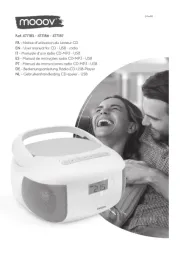
31 Juli 2025
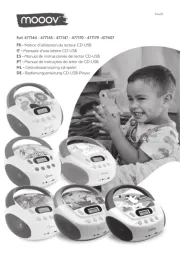
31 Juli 2025
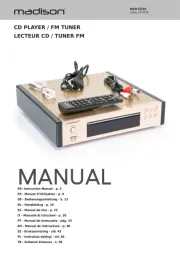
29 Juli 2025
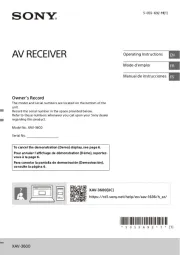
6 Juli 2025
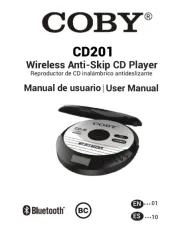
5 Juli 2025
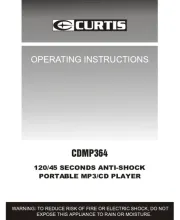
17 Juni 2025
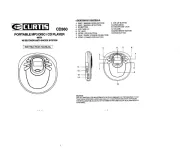
17 Juni 2025

17 Juni 2025
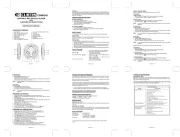
17 Juni 2025
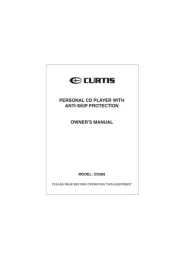
17 Juni 2025